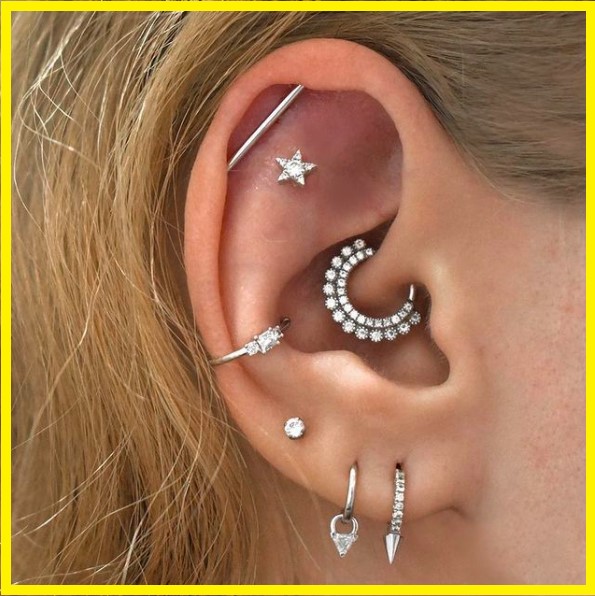The art of Ear piercing is a practice that has transcended time, cultures, and fashion trends. From ancient rituals to modern fashion statements, the art of piercing the earlobe or cartilage has been a symbol of beauty, identity, and personal expression for centuries. In this comprehensive guide, we will delve into the rich history, cultural significance, methods, aftercare, and evolving styles of ear piercing.

Table of Contents
I. A Glimpse into History
Ear piercing is not just a modern trend; it has a fascinating historical legacy. Dating back to ancient civilizations, this practice has taken on various meanings across cultures.
Art of Ear Piercing Ancient Beginnings
Ear piercing dates as far back as 2500 BCE in ancient Egypt. It was a symbol of social status and wealth, with nobility and royals adorning themselves with elaborate jewelry.
Art of Ear Piercing Tribal Traditions
Many indigenous tribes practiced ear piercing as a rite of passage. In some cultures, it represented courage, maturity, or tribal affiliation.
Art of Ear Piercing Cultural Symbolism
In India, ear piercing, particularly among women, is a cultural and religious tradition. It’s believed to enhance one’s well-being and connect with the divine.
II. Modern Revival
The 20th century saw a revival of ear piercing as a fashion statement. Hollywood stars and fashion icons popularized it, leading to a surge in piercing studios and jewelry options.
Art of Ear Piercing Fashion Icons
Icons like Madonna and Cyndi Lauper made multiple ear piercings chic in the 1980s, inspiring countless individuals to embrace the trend.
Art of Ear Piercing Piercing Studios
The rise of professional piercing studios in the late 20th century made the practice safer and more accessible to the masses.
III. Types of Ear Piercings
Ear piercings come in various styles and locations, allowing for personal expression and creativity. Some popular options include:
Art of Ear Piercing Earlobe Piercing
Single lobe piercing
Double lobe piercing
Triple lobe piercing
Helix piercing (upper ear)
Cartilage Piercing
Tragus piercing
Conch piercing
Daith piercing
Rook piercing
Industrial Piercing
A unique style that connects two points on the upper ear with a single barbell.
Art of Ear Piercing Ear Scalpelling
A procedure that enlarges an existing piercing hole to accommodate larger jewelry.
Tunnels and Plugs
Popular among those interested in stretching their earlobes for a bold look.
IV. The Piercing Process
While ear piercing might seem simple, it’s essential to understand the process and take precautions to ensure a safe and comfortable experience.
Choosing a Piercing Studio
Research reputable studios with experienced piercers and proper hygiene standards.
Preparation
Piercers will clean and mark the spot for the piercing, ensuring accuracy and alignment.
Piercing Procedure
Using a sterilized needle or piercing gun (in some cases), the piercer will create the hole and insert jewelry.
Aftercare
Follow strict aftercare instructions to prevent infection and promote healing.
V. Aftercare and Healing
Proper aftercare is crucial to the healing process and maintaining the health of your new piercing.
Cleaning
Use a saline solution or specialized piercing solution to clean the area gently.
Avoid Touching
Resist the temptation to touch or twist the jewelry, as it can introduce bacteria.
Choose the Right Jewelry
Opt for high-quality materials like surgical steel or titanium to avoid allergic reactions.
Healing Time
Healing times vary depending on the type of piercing but typically range from a few weeks to several months.
VI. The Changing Trends
Ear piercing trends evolve over time, with new styles and jewelry options constantly emerging.
Ear Stacking
Layering multiple earrings in a single ear has become a popular trend, allowing for a personalized, unique look.
Ear Cuffs
Non-pierced ear cuffs offer the appearance of multiple piercings without the commitment.
Gemstones and Diamonds
The use of precious stones and diamonds in ear jewelry adds a touch of elegance to ear piercings.
VII. Cultural Significance
Ear piercing still holds cultural significance in many parts of the world.
India
In Indian culture, ear piercing is a sacred tradition called “Karnavedha,” symbolizing the crossing from childhood to adulthood.
Africa
Various African tribes use ear piercing to represent cultural identity, age, and marital status.
Middle East
In the Middle East, ear piercing is a symbol of beauty and femininity.
VIII. Risks and Precautions
It’s essential to be aware of potential risks associated with ear piercing.
Infection
Infections can occur if proper aftercare is not followed.
Allergic Reactions
Some individuals may be allergic to certain metals used in jewelry.
Keloids
Keloid scars can form in individuals with a genetic predisposition.Ear piercing is an enduring art form that continues to evolve and adapt to changing tastes and trends. Whether you choose a classic single lobe piercing or a daring industrial piercing, it’s a practice that allows for self-expression and personal style. With proper care and consideration, ear piercing can be a safe and beautiful way to adorn yourself and carry on a tradition that spans millennia. So, embrace this timeless art, and let your ears tell your unique story through the jewelry you wear


Hi, Does the ear piercings convey any sort of meaning as we do for tattoo?
If yes, please help with helix piercing meaning.